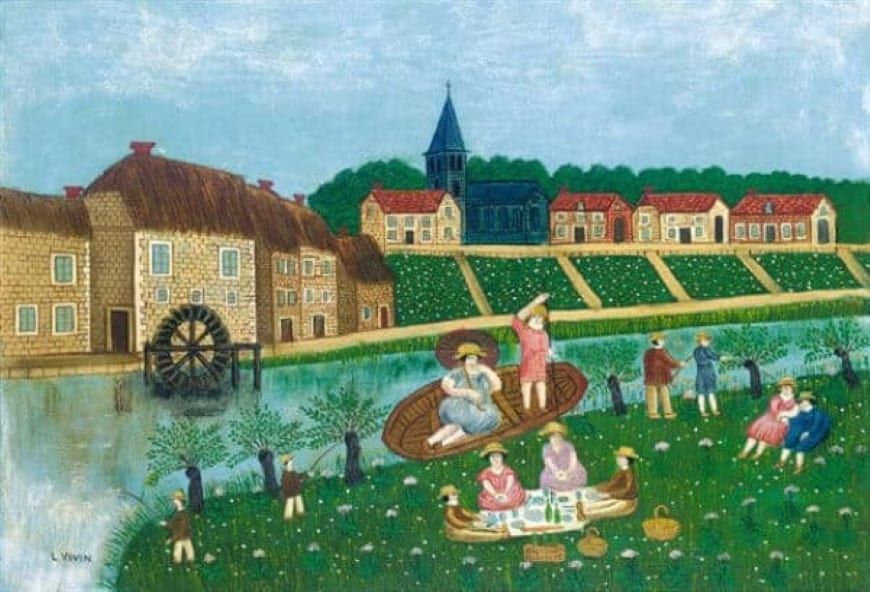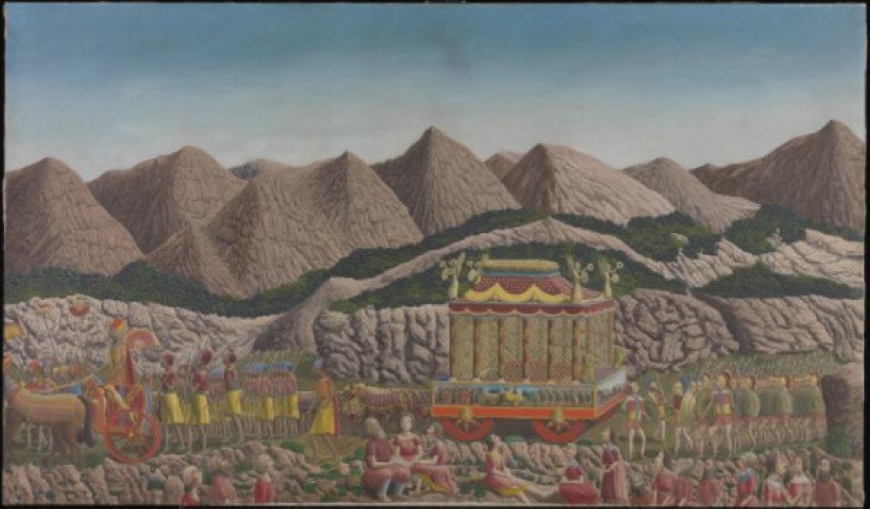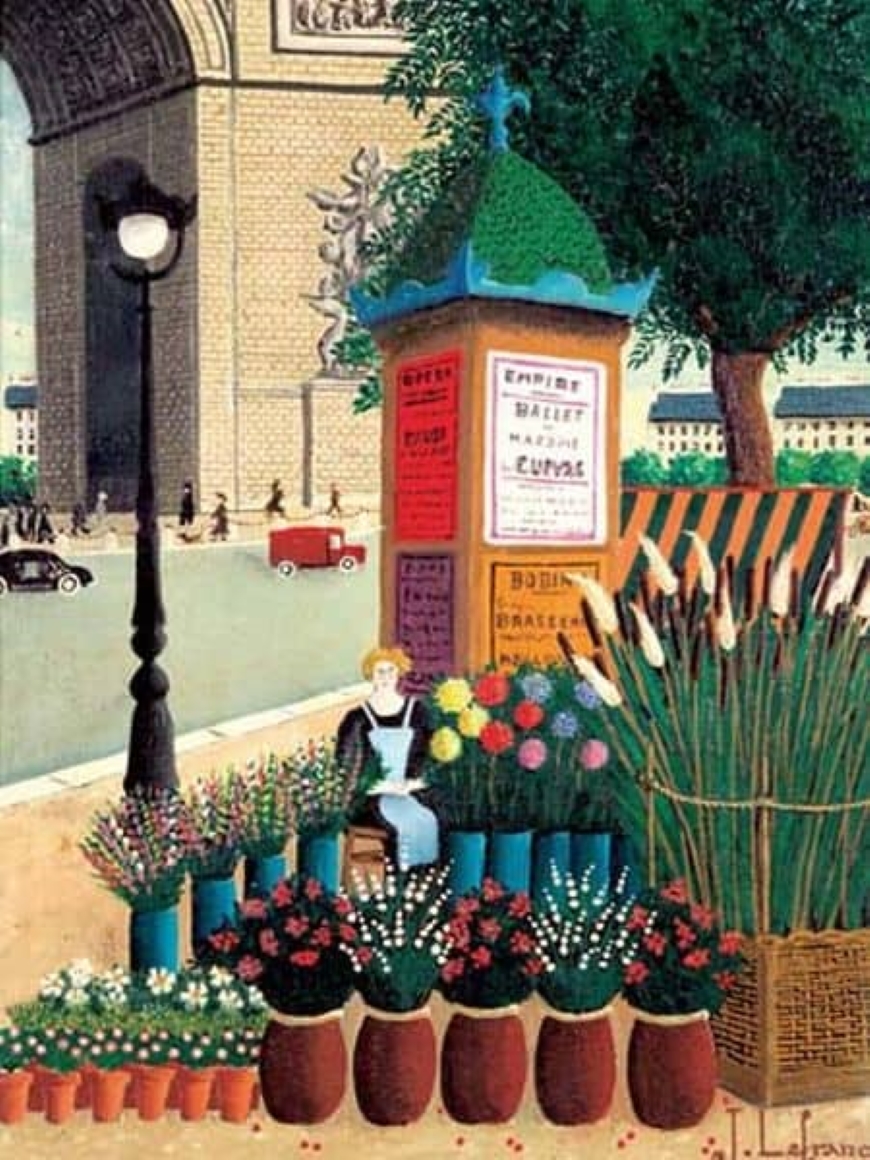
4 CHARACTERISTICS OF NAÏF ART
Naïve art has important characteristics, four of which are:
Strong colors: it mixes bright colors and information that is not true to reality;
Pure and childish vision: naïve artists often create the illusion that their creations are floating;
People, living beings and flora: this art depicts animated characters, never inanimate objects
Precision of details: artists use details in their works, paying attention to soft edges, intense backgrounds and fine lines in their productions.
Another point that is also worth highlighting is that works of art in this style distance their viewers from reality, through a context of freedom, with light and naive elements.
NAÏF ARTISTS AND WORKS OF ART AROUND THE WORLD
As we have already seen, the most famous naïve artist is Henri Rousseau. However, other important names were established. They are: André Bauchant, Alfred Wallis, Louis Vivin and Jules Lefranc.
Next, you will check out all the characteristics described in this article, through its most emblematic pieces:
LE DEJEUNER SUR L’HERBE – LOUIS VIVIN (1925)

MutualArt
VOYAGE TO LABADOR – ALFRED WALLIS (1935-6)

naive painting Credit: Tate
THE FUNERAL PROCESSION OF ALEXANDER THE GREAT – ANDRÉ BAUCHANT (1940)

naive artists Credit: Tate
LA PETITE FLEURISTE – JULES LEFRANC (1953)

main artists naïf artCredit: LotSearch
Do you like art and admire those that deviate from what is considered “conventional”? So, read also: Modern Art Week 1922: modernism, artists and works
In Brazil, naïve art is closely linked to folklore and popular culture. Thus, this style can be seen in cordel woodcuts. Some Brazilian artists, such as Mestre Vitalino, Djanira da Motta e Silva and Heitor dos Prazeres, produced important works of this current.
Did you know that Laart has engravings by Antônio Poteiro and Gilvan Samico in this style? Yes, they are all original and have a certificate of authenticity. Want to check them all out? Just click here.




- April 15, 2025
Gallery Of Painting By Matt Rota - USA

- April 15, 2025
Gallery Of Illustration By Egle Plytnikaite - Lithuania

- April 15, 2025
Gallery Of Humor Drawing By Pierre Ballouhey - France

- April 14, 2025
Gallery of Illustration by Ananda Ferreira – Brazil


- April 14, 2025
Gallery of Illustration by Luis San Vicente – Mexico

- April 14, 2025
Analysis of Artistic Works Created with…

- April 13, 2025
From Digital Art to Contemporary Art

- April 13, 2025
The Expansion of Photography

- April 12, 2025
When is photography considered art?

- April 10, 2025
Impact of AI on the Diversity of Artist…

- April 10, 2025
How can AI enhance artistic creativity?

- April 09, 2025
The Impact of Artificial Intelligence o…

- April 08, 2025
Latin American art, a goldmine of oppor…

- April 07, 2025
Contemporary Art in Brazil: Between the…

- April 07, 2025
Mexican Muralism: Art for the People

- April 06, 2025
History of graphic art in Brazil

- April 05, 2025
Modern Art: A Renaissance in Art History

- April 02, 2025
Aldo Estrada (Ilustronauta): From Peruv…

- March 31, 2025
How ChatGPT is Turning Photos into Japa…

- March 30, 2025
Arístides Hernández (ARES): A Sharp Min…

- March 30, 2025
The Masters of Cuban Caricature: Celebr…

- March 29, 2025
Where Will Artificial Intelligence Take…

- March 27, 2025
A Few Fascinating Features of Latin Ame…

- March 27, 2025
9 Key Books to Understand Latin America…

- March 26, 2025
The Underground: A Glimpse into 1930s L…

- August 29, 2023
The history of Bolivian art

- February 19, 2024
Analysis and meaning of Van Gogh's Star…

- January 28, 2024
Culture and Art in Argentina

- September 25, 2023
What is the importance of art in human …

- September 23, 2023
What is paint?

- August 30, 2023
First artistic manifestations

- August 10, 2023
14 questions and answers about the art …

- August 23, 2023
The 11 types of art and their meanings

- March 26, 2024
The importance of technology in art1

- August 16, 2023
The 15 greatest painters in art history

- September 23, 2023
History of painting

- April 06, 2024
History of visual arts in Ecuador

- January 20, 2024
What is the relationship between art an…

- March 26, 2024
Cultural identity and its impact on art…

- January 31, 2024
Examples of Street Art – Urban Art

- April 07, 2024
Graffiti in Latin American culture

- October 21, 2023
Contemporary art after the Second World…

- September 23, 2023
Painting characteristics

- August 25, 2024
A Comprehensive Analysis of the Cartoon…

- August 08, 2023
Cultural Diversity in Latin American Art

- February 19, 2024
Analysis and meaning of Van Gogh's Star…

- August 13, 2023
9 Latino painters and their great contr…

- August 29, 2023
The history of Bolivian art

- August 10, 2023
14 questions and answers about the art …

- January 28, 2024
Culture and Art in Argentina

- August 23, 2023
The 11 types of art and their meanings

- November 06, 2023
5 Latin American artists and their works

- September 23, 2023
Painting characteristics

- August 27, 2023
15 main works of Van Gogh

- September 23, 2023
What is paint?

- September 25, 2023
What is the importance of art in human …

- August 30, 2023
First artistic manifestations

- January 20, 2024
What is the relationship between art an…

- December 18, 2023
10 iconic works by Oscar Niemeyer, geni…

- January 12, 2024
10 most beautiful statues and sculpture…

- October 30, 2023
Characteristics of Contemporary Art

- March 26, 2024
Cultural identity and its impact on art…

- August 22, 2023
What are Plastic Arts?

- April 16, 2024
The most important painters of Latin Am…

- October 11, 2023


